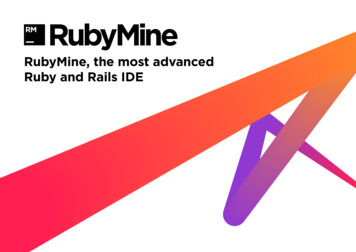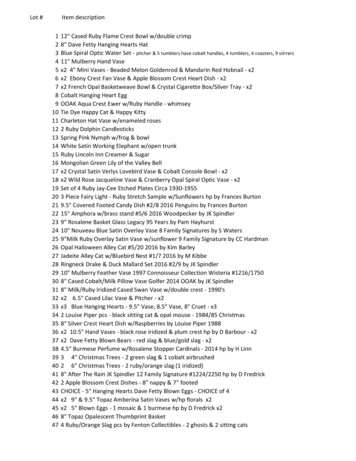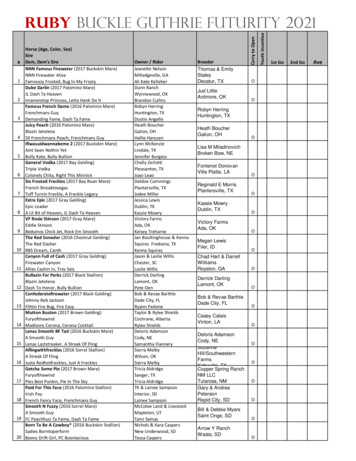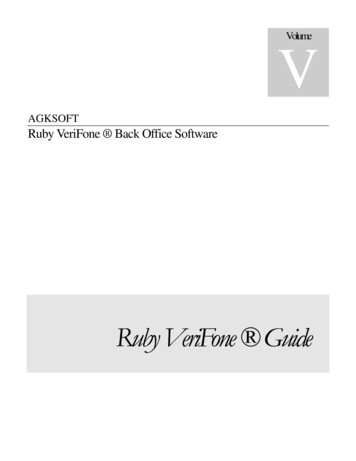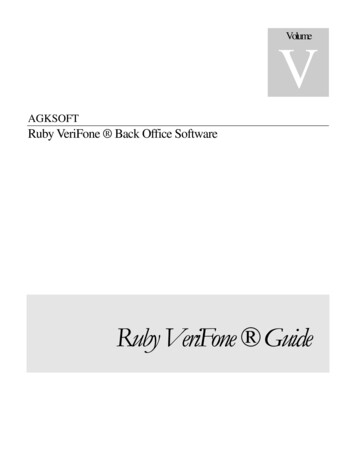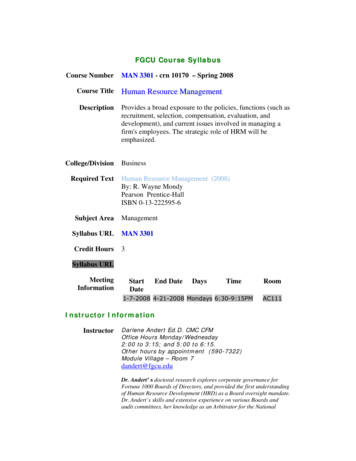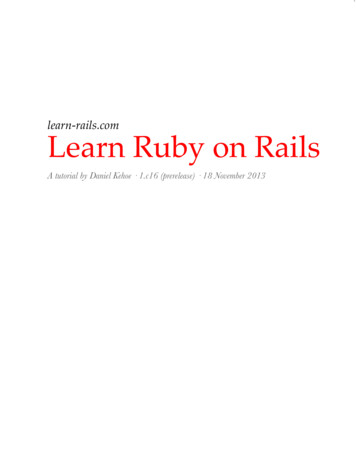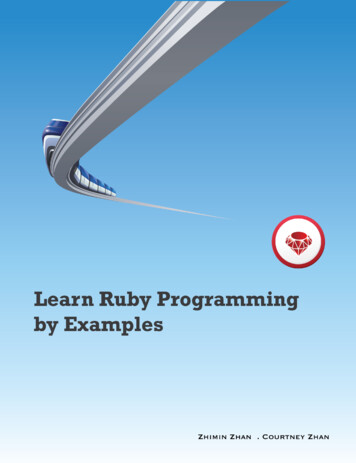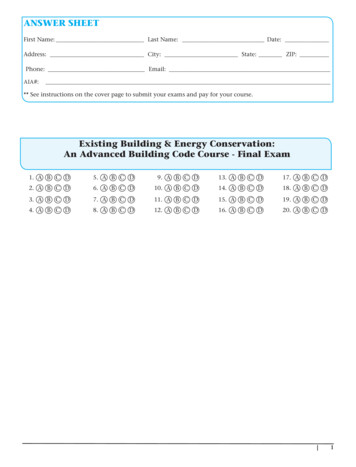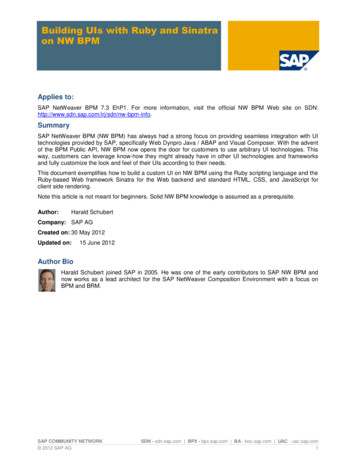
Transcription
Building UIs with Ruby and Sinatraon NW BPMApplies to:SAP NetWeaver BPM 7.3 EhP1. For more information, visit the official NW BPM Web site on marySAP NetWeaver BPM (NW BPM) has always had a strong focus on providing seamless integration with UItechnologies provided by SAP, specifically Web Dynpro Java / ABAP and Visual Composer. With the adventof the BPM Public API, NW BPM now opens the door for customers to use arbitrary UI technologies. Thisway, customers can leverage know-how they might already have in other UI technologies and frameworksand fully customize the look and feel of their UIs according to their needs.This document exemplifies how to build a custom UI on NW BPM using the Ruby scripting language and theRuby-based Web framework Sinatra for the Web backend and standard HTML, CSS, and JavaScript forclient side rendering.Note this article is not meant for beginners. Solid NW BPM knowledge is assumed as a prerequisite.Author:Harald SchubertCompany: SAP AGCreated on: 30 May 2012Updated on:15 June 2012Author BioHarald Schubert joined SAP in 2005. He was one of the early contributors to SAP NW BPM andnow works as a lead architect for the SAP NetWeaver Composition Environment with a focus onBPM and BRM.SAP COMMUNITY NETWORK 2012 SAP AGSDN - sdn.sap.com BPX - bpx.sap.com BA - boc.sap.com UAC - uac.sap.com1
Building UIs with Ruby and Sinatra on NW BPMTable of Contents1Introduction . 31.1About the Demo Project. 32JRuby and Sinatra in a Nutshell . 53Project Setup . 64Modeling the Leave Request Process and Supporting Tasks. 84.1Control Flow . 84.2Data Flow, Part 1 . 104.3Task Creation . 124.4Data Flow, Part 2 . 144.5Sending a Notification . 145Your First Ruby UI . 166Accessing the BPM Public API . 186.1BPM Public API . 186.2A Simple Task List . 186.3Triggering Leave Requests . 206.4Processing Tasks . 227Rounding Off . 237.1Adding More Convenience to the BPM Public API . 238Conclusion . 259Related Content . 2610Copyright . 27SAP COMMUNITY NETWORK 2012 SAP AGSDN - sdn.sap.com BPX - bpx.sap.com BA - boc.sap.com UAC - uac.sap.com2
Building UIs with Ruby and Sinatra on NW BPM1IntroductionThe BPM Public API offers many new possibilities to consume NW BPM, the most prominent one being theaccess via custom UIs, for example those tailored to mobile devices such as iOS or Android handsets.This article guides you through the steps necessary to do just that. I chose Ruby and Sinatra as the UI-tierprogramming language and Web framework, respectively, as I find both ideal for the task at hand: Ruby allows you to quickly pull some scripts together and is a great way to deal with the boiler platecode necessary to connect to the BPM backend through its public APIs. More specifically, JRubyallows you to easily blend Ruby and Java code, making it possible to access the BPM APIs withouthaving to resort to intermediary layers such as REST or SOAP Web services.Sinatra is about the most lightweight Web framework that exists today. It is not as feature-rich ascompetitors such as Ruby on Rails or Python-based Django but what it provides nicely matches thecapabilities needed when building on top of a JEE server and process engine in particular. Forexample, it doesn’t come with its own persistence layer – but this isn’t necessary either as the BPMruntime and your running process instances constitute your persistence, if you will.To better illustrate the topics covered in this document, a simple leave request scenario is used. Theemployee can ask his manager for allowance to take some time off by instantiating a leave request approvalprocess. The manager has the possibility to approve or reject the request. In the latter case, the employeecan either cancel or modify and then re-submit the request (Figure 5: Leave Request Scenario).Figure 1: Demo ProjectThe rest of this document is structured as follows: Chapter 2 gives a brief overview of Ruby and Sinatra and how both are used in NW BPM in ourdemo scenario. For a full coverage of these topics, refer to the references at the end of thedocument.Chapter 3 describes the DC structure used in the leave request scenario and helps you putnecessary things in place such as JRuby and Sinatra libraries.Chapter 4 outlines the leave request process and its associated tasks.Chapter 5 describes how to write a simple Ruby/Sinatra UI and goes into details about a few of theclient-side specifics used in the demo scenario.Chapter 6 shows how to access the BPM Public API and how to consume the data obtained from itin the Ruby UI.Chapter 7 gives an outlook of possible enhancements you could make.Chapter 8 is the conclusion.SAP COMMUNITY NETWORK 2012 SAP AGSDN - sdn.sap.com BPX - bpx.sap.com BA - boc.sap.com UAC - uac.sap.com3
Building UIs with Ruby and Sinatra on NW BPM1.1About the Demo ProjectThe full demo project is based on the NW 7.3 EhP1 release (CE usage type) and can be downloaded onCode Exchange at https://cw.sdn.sap.com/cw/groups/bpm-on-ruby. With limitations, it can be run on NW 7.3as well (refer to the readme.txt in the rubybpm/rbui DC for details).The UI was tested to work with Chrome 18, Firefox 11, and Internet Explorer 9.You will need to access to the sources to complete the exercise as some basic configuration files, utilityclasses and scripts will just be copied to speed up development. If you are among the impatient, you can ofcourse just run the application and read through the code. On Code Exchange (see link above), you will alsofind a description on how to sync from SVN and integrate it into an SAP NWDI/JDI workspace.We nevertheless recommend you to take the effort of writing the code and wiring things together to get themost out of this tutorial.Role AssignmentThe project requires authentication and assumes you log in with the Administrator user having the followingroles assigned: Standard User RoleBPEM End User roleStart Process RoleE-Mail NotificationsThe project makes use of the e-mail notifications feature. Refer to the link below for details on how toconfigure your server properly.http://help.sap.com/saphelp /content.htmProcess VisualizationThe project also leverages the process visualization which needs to be configured analogously to e-mailnotifications. To do so, navigate to NWA Configuration Management Infrastructure Java SystemProperties and edit the http.baseurl of the tc bpem base ear application to match your host name and port.SAP COMMUNITY NETWORK 2012 SAP AGSDN - sdn.sap.com BPX - bpx.sap.com BA - boc.sap.com UAC - uac.sap.com4
Building UIs with Ruby and Sinatra on NW BPM2JRuby and Sinatra in a NutshellRuby is an interpreted scripting language supporting multiple programming styles (specifically functional andprocedural/object-oriented programming) that was invented by Yukihiro Matsumoto with the intent to providea language that is easy to learn and fun to work with. The original version of the interpreter was written in Cin the mid-1990s and still prevails as the leading implementation used in practice. It also serves as thereference implementation against which other implementations must qualify. JRuby is a more recentimplementation that serves the Java community and, as with NW CE / BPM, is particularly attractive if youhave a Java backend you want to work with. With JRuby, you can write beautiful Ruby code while at thesame time leverage the vast code base offered by the Java ecosystem simply by calling (pretty much anytype of) Java code from within a Ruby program.Sinatra is a modular Web framework written in Ruby for providing lightweight Web applications. It follows aREST approach in which you register Ruby handlers with specific (patterns of) URLs to process userrequests and render back HTML or JSON responses, for example:require 'sinatra'get '/hi' do"Hello World!"endThe actual generation of the response markup can be done with your template language of choice. ERB(Embedded Ruby) is the standard template language shipping with Ruby. It is also the one used for thedemo scenario in this project.Rack is a thin adapter layer that basically bridges between Ruby Web servers and Ruby Web frameworks.JRuby-Rack is the counterpart for the Java world, making it possible for you to run a Ruby Web frameworkon a Java Servlet container. Any Web framework providing Rack support automatically runs on all Webservers supported by Rack.With these building blocks in mind, we arrive at the following picture describing the architecture of our leaverequest scenario implementation:Figure 2: Leave Request Scenario ArchitectureSAP COMMUNITY NETWORK 2012 SAP AGSDN - sdn.sap.com BPX - bpx.sap.com BA - boc.sap.com UAC - uac.sap.com5
Building UIs with Ruby and Sinatra on NW BPM3Project SetupBefore we get started with the actual implementation, we will set up the DC structure that we’ll need forstoring our development artifacts. For our application, we need five DCs: BPM DC – Contains your leave request process and tasks.WD UI DC – Contains the WD UIs you get when generating your tasks via the process context. Yourusers don’t really use these UIs but the BPM engine expects them to be there at runtime. Also, thesewill be the UIs that get opened when accessing tasks through UWL. Finally, note this DC is bestcreated for you by using the UI generation coming with NW BPM (see task generation in chapter 4).EAR DC – Assembles the external library dependencies and Web module into a deployable JEEenterprise archive.Web DC – Contains your actual Ruby Web application and any other Java glue code you mightneed.External Library DC – Provides the jars you need for running your Ruby application: JRuby, JRubyRack, the Ruby standard library, and Log4J (used for logging in JRuby and your Web app).This leads to the following picture:Figure 3: DC StructureNote that the runtime dependency between BPM and the EAR DC is purely voluntary. I added it to expressthe fact that the BPM process conceptually depends on the Ruby UIs the same way it depends on the WDUIs. That way, you can ensure that all parts are in place at runtime. If you choose to define a deploy timedependency, too, you can deploy the entire application in a single step by deploying the BPM DC.In addition to the intra-application dependencies outlined above, you will need to add a couple of extradependencies to the EAR and Web DC to gain access to the BPM Public API (all with vendor sap.com):EAR DC: SC BPEM-FAÇADE DC tc/bpem/façade/earo Runtime dependency to DC itself (not the api compilation public part)SC ENGFACADE DC tc/je/sdo21/apio Runtime dependency to DC itself (not the api compilation public part)Web DC:SAP COMMUNITY NETWORK 2012 SAP AGSDN - sdn.sap.com BPX - bpx.sap.com BA - boc.sap.com UAC - uac.sap.com6
Building UIs with Ruby and Sinatra on NW BPM SC ENGFACADE DC tc/je/usermanagement/apio Build time dependency to api compilation public partSC BPEM-FAÇADE DC tc/bpem/façade/earo Build time dependency to api compilation public partSC ENGFACADE DC tc/je/sdo21/apio Build time dependency to api compilation public partSAP COMMUNITY NETWORK 2012 SAP AGSDN - sdn.sap.com BPX - bpx.sap.com BA - boc.sap.com UAC - uac.sap.com7
Building UIs with Ruby and Sinatra on NW BPM44.1Modeling the Leave Request Process and Supporting TasksControl FlowAs explained in the introduction, we’ll look into a leave request process with two roles involved: an employeeand his manager. To that end, create a new process Leave Request Process with a pool Leave Request andtwo lanes in it, and name them Employee and Manager (if you didn’t do so already, create a ProcessComposer DC rubybpm/bpm now):Figure 4: Create ProcessThen, draw the sequence of steps shown in Figure 5: Leave Request Scenario:SAP COMMUNITY NETWORK 2012 SAP AGSDN - sdn.sap.com BPX - bpx.sap.com BA - boc.sap.com UAC - uac.sap.com8
Building UIs with Ruby and Sinatra on NW BPMFigure 5: Leave Request ScenarioBelow you find a brief explanation of all steps: A start event – This event gets triggered through the yet-to-be-built leave request start UI. Itspayload contains all necessary information such as the requester, vacation start and end date, andsome room for notes. The event payload gets stored in a dedicated data object.A merge gateway – a gateway used to merge the flow of execution from a rework leave requestactivity back into beginning of a process to re-initiate the manager approval.A manager approval human activity – the manager is asked to either approve or reject the leaverequest at this point. His decision gets stored in a boolean field in the same data object in which thestart event payload was stored.An exclusive choice gateway – this is the point at which based on the manager’s decision, theprocess either finishes by sending out a notification to the employee or the employee gets theopportunity to change his request or cancel it altogether.A rework leave request human activity – the leave request rework step for the employee. Noteyou can only add the boundary event once you assigned a task to the activity (chapter 4.3).A notification activity – the step in which a leave request confirmation mail is sent to the employee.An end event – terminates the leave request process.SAP COMMUNITY NETWORK 2012 SAP AGSDN - sdn.sap.com BPX - bpx.sap.com BA - boc.sap.com UAC - uac.sap.com9
Building UIs with Ruby and Sinatra on NW BPM4.2Data Flow, Part 1To begin with, create these two files inside the src/wsdl folder of your BPM DC:LeaveRequestData.xsd: ?xml version "1.0" encoding "UTF-8"? schema xmlns http://www.w3.org/2001/XMLSchematargetNamespace http://com.sap.demo/LeaveRequestDataxmlns:tns efault "qualified" complexType name "LeaveRequestData" sequence element name "requester" type "string" /element element name "fromDate" type "date" /element element name "toDate" type "date" /element element name "notes" type "string" /element element name "approved" type "boolean" /element /sequence /complexType /schema LeaveRequestProcess.wsdl: ?xml version "1.0" encoding "UTF-8" standalone "no"? wsdl:definitions xmlns:leaveapp ap "http://schemas.xmlsoap.org/wsdl/soap/"xmlns:wsdl "http://schemas.xmlsoap.org/wsdl/"xmlns:xsd "http://www.w3.org/2001/XMLSchema" name "LeaveRequestProcess"targetNamespace "http://com.sap.demo/LeaveRequestProcess/" wsdl:types xsd:schema targetNamespace "http://com.sap.demo/LeaveRequestProcess/" xsd:complexType name "LeaveRequest" xsd:sequence xsd:element name "requester" type "xsd:string" /xsd:element xsd:element name "fromDate" type "xsd:date" /xsd:element xsd:element name "toDate" type "xsd:date" /xsd:element xsd:element name "notes" type "xsd:string" /xsd:element /xsd:sequence /xsd:complexType xsd:element name "requestLeave"type "leaveapp:LeaveRequest" /xsd:element xsd:element name "requestLeaveResponse" xsd:complexType xsd:sequence /xsd:sequence /xsd:complexType /xsd:element /xsd:schema /wsdl:types wsdl:message name "requestLeaveRequest" wsdl:part element "leaveapp:requestLeave" name "parameters" / /wsdl:message wsdl:message name "requestLeaveResponse" wsdl:part element "leaveapp:requestLeaveResponse" name "parameters" / /wsdl:message wsdl:portType name "LeaveRequestProcess" wsdl:operation name "requestLeave" wsdl:input message "leaveapp:requestLeaveRequest" / wsdl:output message "leaveapp:requestLeaveResponse" / /wsdl:operation /wsdl:portType SAP COMMUNITY NETWORK 2012 SAP AGSDN - sdn.sap.com BPX - bpx.sap.com BA - boc.sap.com UAC - uac.sap.com10
Building UIs with Ruby and Sinatra on NW BPM wsdl:binding name "LeaveRequestProcessSOAP" type "leaveapp:LeaveRequestProcess" soap:binding style "document"transport "http://schemas.xmlsoap.org/soap/http" / wsdl:operation name "requestLeave" soap:operationsoapAction ave" / wsdl:input soap:body use "literal" / /wsdl:input wsdl:output soap:body use "literal" / /wsdl:output /wsdl:operation /wsdl:binding wsdl:service name "LeaveRequestProcess" wsdl:port binding "leaveapp:LeaveRequestProcessSOAP"name "LeaveRequestProcessSOAP" soap:address location "http://com.sap.demo/" / /wsdl:port /wsdl:service /wsdl:definitions You should now see the following tree (refresh the project if this isn’t the case):Figure 6: Import XSD and WSDLSAP COMMUNITY NETWORK 2012 SAP AGSDN - sdn.sap.com BPX - bpx.sap.com BA - boc.sap.com UAC - uac.sap.com11
Building UIs with Ruby and Sinatra on NW BPMNext, drag the service interface operation requestLeave shown in Figure 6: Import XSD and WSDL onto thestart and end event. This will set the WSDL operation as the Web service interface of the leave requestprocess through which you can create new leave request instances.Now, drag the LeaveRequestData data type onto the pool (not the pool header but either lane). This willcreate a data object with the data type set to exactly the one you dragged (rename it as you see fit).The data object will basically capture the operational state of the leave request, including the managerapproval status. Use the approved field to implement the condition in the exclusive choice gateway.You are now also ready to do a data mapping from the start event payload onto the data object. To this end,do a right-drag from the start event payload on the left to the LeaveRequestData data object on the right:Figure 7: Start Event Payload MappingThis will do a name-based matching of source data structure onto the target data structure.4.3Task CreationBefore we can continue mapping process context data into the approval and rework steps, we need to createtasks for them. The nice side effect of defining the process context first is that tasks and UIs can be nicelygenerated from there. Go to the Task tab of the approval step and select New from the Task drop-down.This will launch the task creation wizard. Enter a name for the approval task, e.g.ApproveLeaveRequestTask, ensure the Generate UI Component checkbox is checked, then hit Next,confirm the pre-selected Leave Request Process, and you end up in a wizard step where you need to selectUI technology and DC. Stick to WebDynpro, create a new development component rubybpm/wdui, confirmthe WD UI component details on the next wizard screen, and you will end up in a step where you need tochoose the portion of the process context you want to take over into your task UI. Take everything:SAP COMMUNITY NETWORK 2012 SAP AGSDN - sdn.sap.com BPX - bpx.sap.com BA - boc.sap.com UAC - uac.sap.com12
Building UIs with Ruby and Sinatra on NW BPMFigure 8: Create Approve Task UINow, do the same for the rework task, naming it ReworkLeaveRequestTask and choose the followingprocess context:Figure 9: Create Rework Task UISAP COMMUNITY NETWORK 2012 SAP AGSDN - sdn.sap.com BPX - bpx.sap.com BA - boc.sap.com UAC - uac.sap.com13
Building UIs with Ruby and Sinatra on NW BPMAt this point, you have to do the usual things like assigning potential owners to the tasks, defining user textsthat are to be shown in UWL or your custom work list. I leave it to you as an exercise to come up with a gooddesign here – for the purpose of this exercise, all roles are set to Administrator anywhere a role is requiredand it is assumed you log in with this user (see chapter 1.1 for details).Also, make sure you add the boundary event to the rework task. In case you chose to name the rework taskas I did, the boundary event you want to pick should read ReworkLeaveRequestErrorEvent.4.4Data Flow, Part 2With tasks in place, we can close off data flow definition. We need to do the following things: (1) do an inputmapping from our data object into the approval task, (2) an output mapping from the approval task back tothe data object, and (3) repeat both of these steps for the rework task. Be careful not to accidentallyoverwrite the approved flag during the output mapping of the rework task. Here is one example for theapproval input mapping:Figure 10: Approval Input Mapping4.5Sending a NotificationFinally, we want to send a notification in case the leave request was approved. To shorten things a bit, hereis the configuration that should do the trick for our scenario:SAP COMMUNITY NETWORK 2012 SAP AGSDN - sdn.sap.com BPX - bpx.sap.com BA - boc.sap.com UAC - uac.sap.com14
Building UIs with Ruby and Sinatra on NW BPMFigure 11: Notification ConfigurationRemember you need to have your NW AS Java configured properly in order to receive notification mails (seechapter 1.1 for details).At this point, you should be able to trigger of a leave request process instance and run it to completion. Tryand test this using the process start UI reachable through NWA.SAP COMMUNITY NETWORK 2012 SAP AGSDN - sdn.sap.com BPX - bpx.sap.com BA - boc.sap.com UAC - uac.sap.com15
Building UIs with Ruby and Sinatra on NW BPM5Your First Ruby UISo we now have a fully working leave request process running, including tasks and auto-generatedWebDynpro Java UIs – great. Let’s now try to get going with our own custom UIs.If you didn’t create the EAR DC, Web DC, and External Library DC so far, now is a good time to do so. Payspecial attention to the public parts and dependencies between DCs (see chapter 3).After that, download the libraries shown in Figure 12: Publish as Archive from the Web and copy them to thelibraries folder of the External Library DC and add them as an archive to the archives assembly and apicompilation public part, respectively:Figure 12: Publish as ArchiveSAP COMMUNITY NETWORK 2012 SAP AGSDN - sdn.sap.com BPX - bpx.sap.com BA - boc.sap.com UAC - uac.sap.com16
Building UIs with Ruby and Sinatra on NW BPMFigure 13: Add to Public PartsThat’s it for the external libraries. The next step is a bit more involving. I initially came up with the structure ofthis DC using Warbler, a tool that assembles a standard ruby application into a Java Web archive togetherwith all of its dependencies, and then migrating bit by bit to a DC structure. I will not go into details of eachconcept and configuration file here. After all, this is not a Ruby tutorial. The simplest would be to get thesource files accompanying this article, extract the rubybpm/rbui DC, and – after backing up old files – copythe following things to your own DC: uby-Rack config fileJava Web config fileSAP AS Java config fileRuby gems we’ll depend onPublic CSS, JavaScript, and imagesSome Ruby helpers we useSome Java helpers we use, Log4J configurationMake sure to change the display-name property in web.xml back to the correct value(LocalDevelopment rubybpm rbui demo.sap.com in our example).Then, create a file WebContent/WEB-INF/rubyweb.rb and folder WebContent/WEB-INF/views. We’ll write ourUI controller code and place our view templates here, respectively.Open rubyweb.rb and add the Sinatra code snippet given in chapter 2. Deploy the EAR DC to your serverand point your application to rbui app root /hi (e.g. http://localhost:50000/demo.sap.com rubybpm rbui/hi).You should see a hello world message.Side note: if you prefer using a dedicated Ruby editor with syntax highlighting, look out for the Eclipse DLTKwhich comes with a sample Ruby editor (http://www.eclipse.org/dltk/).SAP COMMUNITY NETWORK 2012 SAP AGSDN - sdn.sap.com BPX - bpx.sap.com BA - boc.sap.com UAC - uac.sap.com17
Building UIs with Ruby and Sinatra on NW BPM66.1Accessing the BPM Public APIBPM Public APIThe BPM Public API is the entry point to programmatically accessing NW BPM and allows you to addressboth task and process-related aspects. We won’t cover it in detail here. For details, refer to the online help onhttp://help.sap.com/javadocs/.Figure 14: BPM Public API6.2A Simple Task ListNow that the basic JRuby setup is done, it is time for something more BPM-like. The first thing we want to tryis building our own worklist. We will need to configure authentication to retrieve tasks for a particular user.The files we copied in chapter 5 where a good starting point to get the project configured properly andprovide some basic helpers that will ease development.As we’ll do real coding now, it might be a good idea to discuss a practical but important aspect of developingwith JRuby: when to use Java and when Ruby. Obviously, JRuby offers support for both. That means, youcan decide what pieces of functionality you want to develop in plain old Java and what pieces are betterdone with Ruby. There is no strictly technical answer to this question. In the end, it comes down to a matterof taste. I prefer to use Java when I heavily access Java APIs anyway (such as the BPM Public API), andthen create thin wrappers that I call from Ruby to implement the UI logic. This is what you will find in thisexercise.To begin with, create a Java class TaskManager and place it in the rubybpm/rbui DC. Implement it as follows(package name and imports omitted; you can find the fully implemented version of this class in thetest.rubyweb.tasks Java package):public class TaskManager {static Logger logger Logger.getLogger(TaskManager.class);SAP COMMUNITY NETWORK 2012 SAP AGSDN - sdn.sap.com BPX - bpx.sap.com BA - boc.sap.com UAC - uac.sap.com18
Building UIs with Ruby and Sinatra on NW BPMpublic TaskAbstract[] getMyTasks() {try {TaskInstanceManager taskInstanceManager BPMFactory.getTaskInstanceManager();HashSet Status statuses new HashSet Status RESERVED);statuses.add(Status.IN PROGRESS);Set TaskAbstract myTasks eturn myTasks.toArray(new TaskAbstract[0]);} catch (BPMException e) {logger.error(e.getMessage(), e);}return new TaskAbstract[0];}}This will yield an array of ready, reserved, and in-process task abstracts for the current user. Now, we onlyneed to invoke this method from our Ruby code and render the information in a nice HTML table. To do so,open rubyweb.rb and add another GET handler:get '/tasks/?' doinclude class 'com.foo.bar.TaskManager' #change accordinglytm TaskManager.new@tasks tm.my taskserb :tasksendThis requires some explanation. When the Sinatra Web application receives a GET request, all registeredGET handlers are matched against the request’s URL (to be precise, the portion of the URL relative to theWeb application root URL). When a matching handler is found, it is executed.What we now do in our coding is importing the Java class we previously implemented and creating a newinstance we can work with. We then invoke the getMyTasks() method and store the array of tasks in amember variable. Note how JRuby automatically translates between snake case used in Ruby andcamelCase found in Java as well as getter/setter convention differences between the languages so you canuse the syntax that’s common in each language. Finally, we render a view template that we yet have to write.Member variables have a special meaning in Sinatra: they are available when rendering view templates.Appli
(Embedded Ruby) is the standard template language shipping with Ruby. It is also the one used for the demo scenario in this project. Rack is a thin adapter layer that basically bridges between Ruby Web servers and Ruby Web frameworks. JRuby-Rack is the counterpart for the Java world, making it poss
